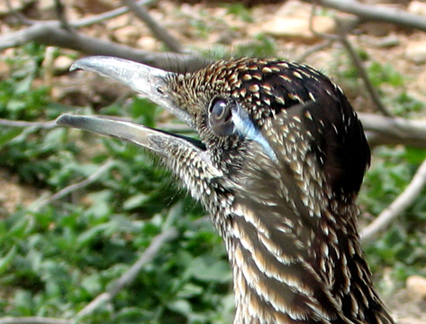|
This photograph was taken at the Arizona-Sonora Desert Museum. Desert Duets: Greater Roadrunner Info Web Page Information about Roadrunners Have you ever watched the cartoon characters Roadrunner and Wiley E. Coyote? In real life, do clever roadrunners always escape bumbling coyotes? Does a roadrunner actually make the sound "mheep, mheep" like the bird in the cartoon? The animated bird in these cartoons has a lot in common with real roadrunners. Like the cartoon bird, actual roadrunners prefer to run along the ground rather than fly. When running in a straight line, their heads and tails are parallel to the ground, just like in the cartoon. Roadrunners can reach speeds of up to 17 or 18 miles an hour when they're fleeing their predators: hawks, bobcats, house cats, raccoons, rat snakes, bull snakes, skunks, and sometimes, coyotes. Most of roadrunners' predators, including coyotes, eat roadrunner eggs and nestlings because adult roadrunners zigzag, leap, and run too fast to be caught. Unfortunately, because they spend most of their time on the ground, these birds are often hit by cars. Like the other members of the cuckoo family, roadrunners have a crest of feathers on top of their heads. There are two species, but only the greater roadrunner lives in the United States and northern Mexico. It is two feet long and has black skin and black, white, and tan feathers. Roadrunners have bare skin eye rings. The greater roadrunner's eye-ring colors go from blue to white to orange. Unless they are excited, small feathers cover the white and orange skin. All roadrunners have four toes on each foot, two toes point forward and two point to the back. Although they will eat some seeds or fruits in the winter, roadrunners prefer to eat insects, spiders, scorpions, beetles, lizards, mice, bats, and snakes. Nicknamed "snakebird," a roadrunner can capture and eat snakes, including rattlesnakes. First, the bird dances, darts, leaps, and flaps its wings to create a moving target that confuses the snake. Then, it uses its sharp beak to stab the snake. Finally, the roadrunner beats it on the ground and swallows it head first. Sometimes the snake is still alive! Roadrunners make a cooing
sound to communicate with their mates. (Link
to the resources page below to hear it.) They also have a call that
is similar to a dog's bark, and they make clacking sounds with their
beaks. However, they don't make the "mheep, mheep" sound like
the roadrunner in the cartoons. Greater Roadrunner Pages:
Home | Information
| Babies | Activity
| Resources |
